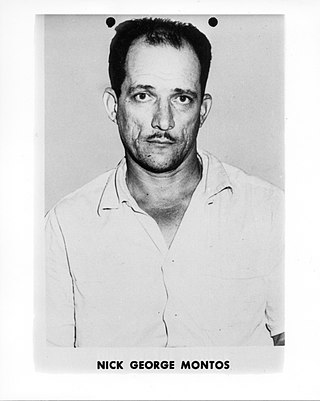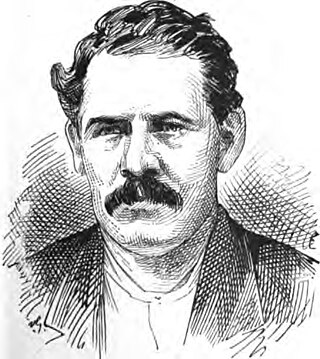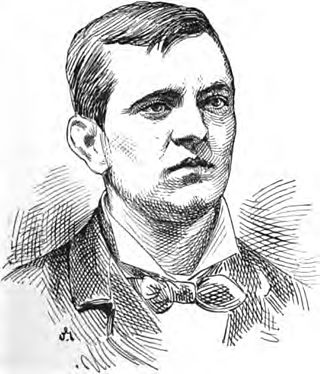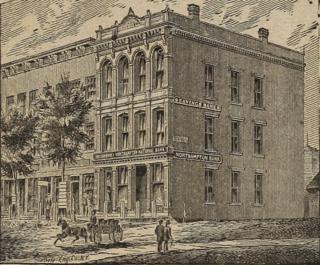Related Research Articles

John Herbert Dillinger was an American gangster during the Great Depression. He commanded the Dillinger Gang, which was accused of robbing 24 banks and four police stations. Dillinger was imprisoned several times and escaped twice. He was charged with but not convicted of the murder of an East Chicago, Indiana, police officer, who shot Dillinger in his bullet-proof vest during a shootout; it was the only time Dillinger was charged with homicide.

James Burke, also known as "Jimmy the Gent", was an American gangster and Lucchese crime family associate who is believed to have organized the 1978 Lufthansa heist, the largest cash robbery in American history at the time. He was believed to be responsible for the deaths of those involved in the months after the robbery.

Harry "Pete" Pierpont was a Prohibition era gangster, convicted murderer and bank robber. He was a friend and mentor to John Dillinger.

Paul Vario was an American mobster and made man in the Lucchese crime family. Vario was a caporegime and had his own crew of mobsters in Brooklyn, New York. Following the testimony of Henry Hill, Vario was convicted in 1984, of fraud, and sentenced to four years in prison, followed by a conviction for extortion in 1985, and an additional sentence of 10 years in prison. He died on May 3, 1988, of respiratory failure in prison.
The Dutch Mob was a New York pickpocket gang during the late nineteenth century.
Gerald Chapman, known as "The Count of Gramercy Park", "The Gentleman Bandit", and "Gentleman Gerald", was an American criminal who helped lead an early Prohibition-era gang from 1919 until the mid-1920s. His nicknames came from his ability to pose as a member of the wealthy elite, which allowed him to fool potential victims and avoid scrutiny from investigators. Chapman was the first criminal to be dubbed "Public Enemy Number One" by the press.
George Leonidas Leslie, who sometimes used the names George Howard and George Herbert, was an American bank robber and architect. He was involved in 80% of the bank robberies in the United States from 1869 to 1878, and was known as "The King of Bank Robbers".
Doris Marie Payne is an American convicted jewel thief.

Nicholas George Montos was an American criminal, associate of the Chicago Outfit and a fugitive. Montos was the first person to be placed twice on the FBI Ten Most Wanted Fugitives list. At his death in 2008 aged 92, Montos was the oldest inmate in the state of Massachusetts.
The Whittemore Gang was a group of bank robbers active in the Mid-Atlantic and Eastern United States during the mid-1920s. Led by Richard Reese Whittemore, the gang, including his wife Margaret, went on a year-long crime spree committing payroll, bank and jewelry robberies in Maryland and New York before their capture in 1926.
Elmer H. Inman was an American criminal, bank robber, jewel thief and Depression-era outlaw. At one time considered Oklahoma's "Public Enemy No. 1", he was a member of the Kimes-Terrill Gang and associated with Herman Barker and Wilbur Underhill, Jr. throughout the early-1930s.

Lawrence Robert Lawton is an American ex-convict, author, paralegal, motivational speaker, and YouTuber. Lawton gained notoriety for committing a string of jewelry store robberies along the Atlantic Seaboard prior to his arrest in 1996. He spent 12 years in prison, and once released, began a career as a motivational speaker, life coach, and author.

William O'Brien, better known as Billy Porter but also known by the alias William or Billy Morton, was an American burglar and underworld figure in New York City during the mid-to late 19th century. He and partner Johnny Irving were longtime members of the Dutch Mob along with Little Freddie and Michael "Sheeny Mike" Kurtz. He was present during the 1883 gunfight at Shang Draper's saloon in which Irving was shot and killed by rival John "Johnny the Mick" Walsh. O'Brien then killed Walsh and was himself gunned down by Shang Draper. Although surviving his wounds, he was tried for, and acquitted of, Walsh's death.

Michael "Pugsey" Hurley, also known by the aliases Pugsey Reilly or Hanley, was an English-born American burglar, river pirate and underworld figure in New York City during the mid-to late 19th century. An old time thief from the old Seventh Ward, he was also a well-known waterfront thug whose criminal career lasted over two decades. He especially gained notoriety as a member of the Patsy Conroy Gang and was a principal figure in many of their most infamous crimes.

James "Old Jimmy" Hope was a 19th-century American burglar, bank robber and underworld figure in Philadelphia and later New York City. He was considered one of the most successful and sought after bank burglars in the United States during his lifetime as well as a skilled escape artist for his repeated breakouts from Auburn State Prison in New York.

John Hope (1856–1906) was a 19th-century American burglar, bank robber and pickpocket. The son of James "Old Jimmy" Hope, he was alleged to have been associated with his father and the George Leslie Gang. He was among those arrested for the 1878 robbery of the Manhattan Savings Institution although he and Billy Kelly were the only men actually sent to prison for this crime.

James E. Logue was a Philadelphia based burglar who is thought to have stolen more than $300,000 over the course of his criminal career. He mostly targeted homes and shops but also occasionally banks and spent time in and out of jail. In brief announcements of his death in 1899, he was referred to as "the notorious bank robber". He is perhaps better known for the disappearance of his third wife, Joanna, who was later discovered to have been murdered by her nephew, Alphonso Cutaiar.
Organized crime in the 1880s.

On Sunday, October 27, 1878, the Manhattan Savings Institution bank and depository in Manhattan, New York City was robbed of $2,747,700 in cash and securities by the former gang of serial bank robber George Leonidas Leslie. It is one of the largest bank robberies in U.S. history, which surpassed Leslie's 1876 Northampton bank robbery.

On January 26, 1876, the Northampton Bank in Northampton, Massachusetts, was robbed of $1.6 million in cash, bonds, and other securities by the Rufus Gang, which was lead by Thomas Dunlap, Robert Scott, and George Leonidas Leslie. Leslie planned the robbery, but did not participate physically. It was the largest bank robbery in U.S. history until it was surpassed in 1878 by the Leslie's robbery of the Manhattan Savings Institution. 75 depositors lost their money.
References
- Asbury, Herbert. The Gangs of New York. New York: Alfred A. Knopf, 1928. ISBN 1-56025-275-8
- Byrnes, Thomas. 1886 Professional Criminals of America. New York: Chelsea House Publishers, 1969.